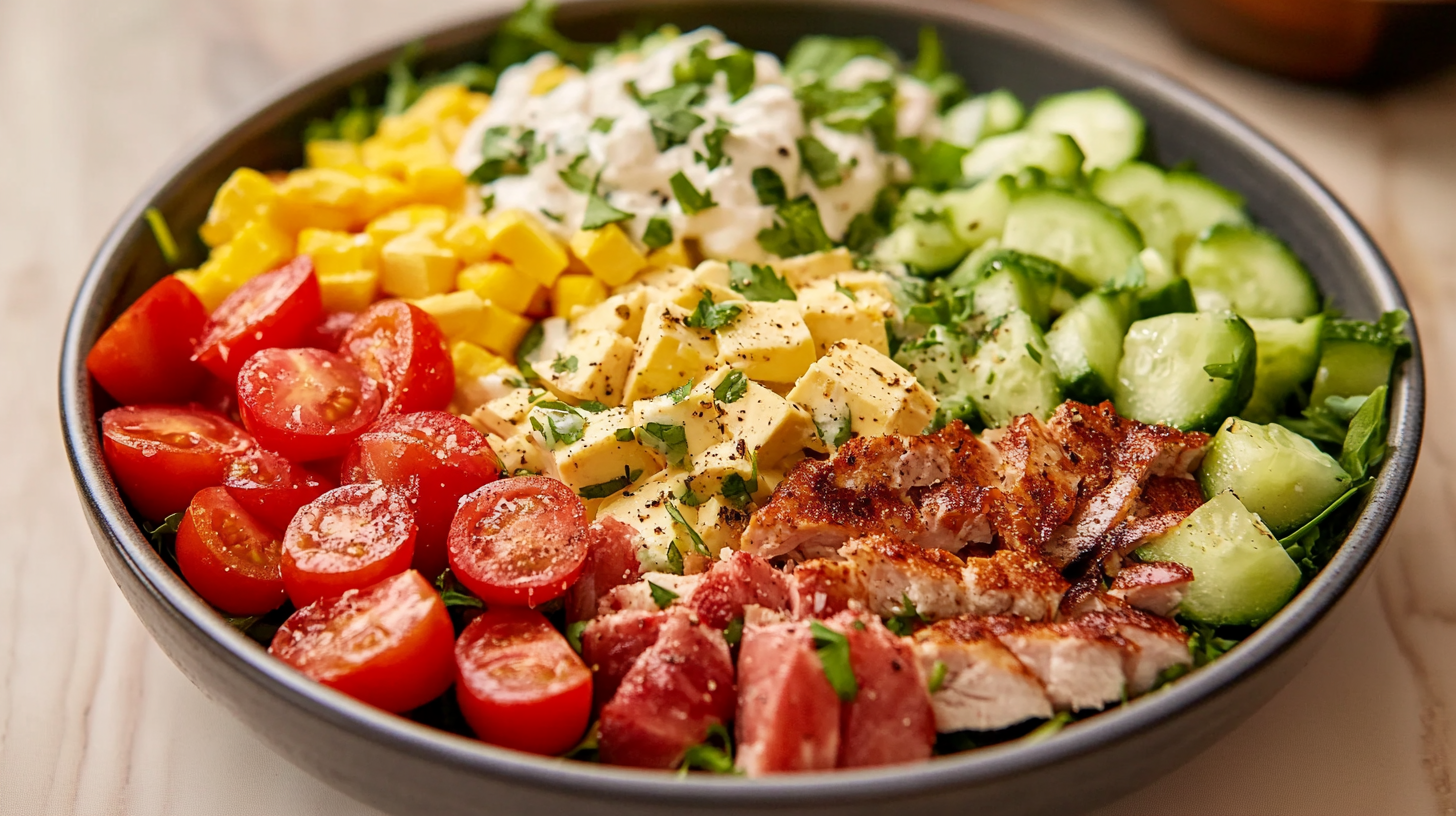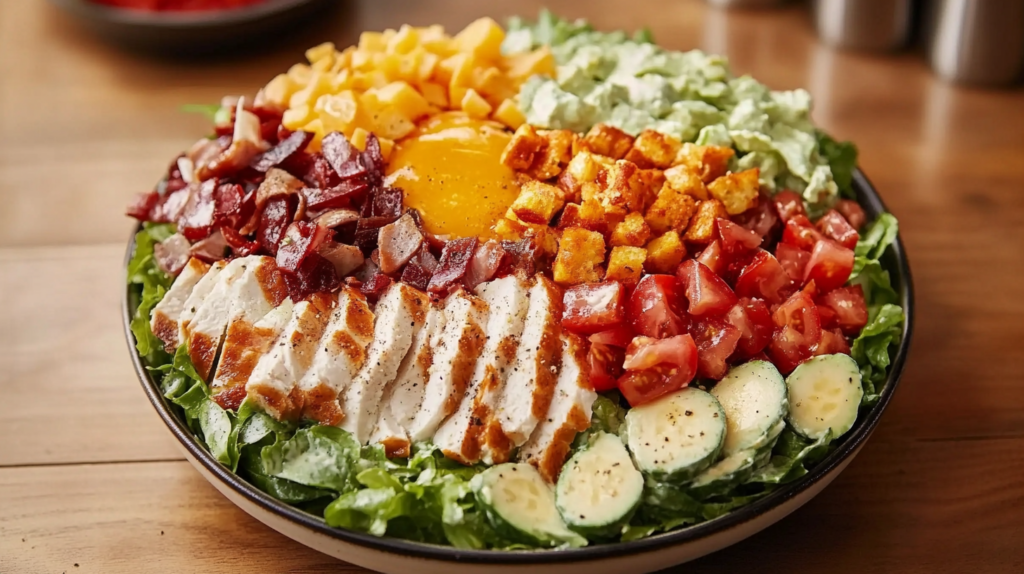The Cobb salad is a timeless classic that combines crisp greens, savory proteins, fresh vegetables, and a rich dressing. With its origins rooted in American culinary history, this salad has gained popularity for its versatility and balanced ingredients. Whether you stick with the traditional lineup or add your own twist, the Cobb salad provides a satisfying, nutrient-rich meal that’s ideal for lunch or dinner. In this guide, we’ll dive into its origin story, explore the classic ingredients, share step-by-step instructions for making it at home, and introduce some delicious variations to keep things interesting.
The Origin of the Classic Cobb Salad
How the Cobb Salad Came to Be
The Cobb salad has a fascinating history, dating back to 1937. Created by Robert Cobb, owner of the famed Brown Derby restaurant in Los Angeles, this salad was assembled from a variety of ingredients he found in his kitchen. The story goes that Cobb was searching for a late-night meal and decided to throw together leftovers, crafting what would become an iconic American dish. This impromptu creation quickly gained popularity, eventually becoming a menu staple at the Brown Derby and beyond.
Why the Cobb Salad is So Popular
What sets the Cobb salad apart is its careful layering of flavors and textures, from crispy lettuce to creamy avocado and tangy blue cheese. Each ingredient in a Cobb salad brings something unique to the table, making it as enjoyable to eat as it is to look at. The variety of proteins and fresh produce make it filling yet balanced, providing plenty of nutrients along with its delicious taste.
In the next section, we’ll explore the ingredients that make up this legendary salad and explain why each one plays a crucial role in delivering that perfect Cobb salad experience.
Traditional Ingredients of a Cobb Salad
Each ingredient in a Cobb salad has a purpose, combining to create a symphony of textures and flavors. Below, we break down the essential elements of a classic Cobb salad.
The Greens: The Foundation of Flavor
A true Cobb salad starts with a base of fresh, crisp greens that serve as the foundation for the toppings. Typically, a mix of romaine lettuce, iceberg lettuce, and watercress is used to bring both a satisfying crunch and a mild flavor. The combination of these greens helps balance the rich flavors of the toppings.
The Proteins: Chicken, Bacon, and Hard-Boiled Eggs
Grilled or Roasted Chicken: Chicken provides lean protein and a neutral flavor that complements the other ingredients. It’s often grilled or roasted for added flavor without overpowering the dish.
Crispy Bacon: Bacon brings a smoky, salty note to the salad, adding depth to each bite. For the best texture, cook the bacon until crispy, so it contrasts with the softer ingredients.
Hard-Boiled Eggs: Eggs offer a creamy texture and a mild flavor that ties the salad together. They’re typically hard-boiled and sliced or quartered for easy mixing.
Fresh Produce: Avocado, Tomatoes, and Chives
Avocado: Creamy and rich, avocado adds a unique texture that balances the crunch of the greens. Its mild, buttery flavor pairs well with the other ingredients and adds healthy fats to the dish.
Tomatoes: Juicy tomatoes bring a sweet, tangy element that brightens the flavors of the salad. Diced tomatoes work best, as they’re easy to distribute evenly across the salad.
Chives: Finely chopped chives add a subtle, onion-like flavor that enhances the salad without overpowering it.
The Cheese: Blue Cheese for a Bold Contrast
Blue Cheese: The classic choice for a Cobb salad, blue cheese offers a creamy, tangy bite that contrasts well with the salad’s other flavors. Crumbled blue cheese, such as Roquefort, adds a distinct flavor that elevates the salad from simple to sophisticated.
Dressing: The Final Touch
Red Wine Vinaigrette: Traditionally, Cobb salad is topped with a red wine vinaigrette that complements the rich ingredients without overwhelming them. Made with olive oil, red wine vinegar, Dijon mustard, minced shallots, salt, and pepper, this dressing adds a tangy, slightly acidic note that balances the flavors.
In the next section, we’ll guide you through assembling the perfect Cobb salad, step-by-step, to ensure that each ingredient shines.
How to Assemble the Perfect Cobb Salad
Creating a balanced Cobb salad is all about layering flavors and textures. Follow these steps to make a visually appealing and delicious salad that combines every element seamlessly.
1: Prepare Your Ingredients
- Wash and Chop the Greens: Rinse and dry romaine lettuce, iceberg lettuce, and watercress thoroughly. Chop them into bite-sized pieces for easy eating and even distribution.
- Cook the Proteins:
- Chicken: Grill or roast the chicken breasts until fully cooked, then let them cool before slicing or dicing.
- Bacon: Cook bacon until crispy, then drain excess oil and crumble it into pieces.
- Eggs: Boil eggs to a hard-boiled state (around 10 minutes), then peel and slice or quarter.
- Dice the Produce:
- Tomatoes: Dice tomatoes to keep them small and easy to mix.
- Avocado: Slice or cube the avocado, adding it just before serving to prevent browning.
- Chives: Finely chop chives for a subtle touch of flavor.
- Crumble the Cheese: Crumble blue cheese to sprinkle on top.
2: Assemble the Salad
- Create a Bed of Greens: Lay the chopped greens evenly on a large platter or individual salad plates. Spread them out to form a base that’s ready for the toppings.
- Arrange the Toppings in Rows: For a classic presentation, arrange the chicken, bacon, eggs, tomatoes, avocado, and blue cheese in neat, parallel rows across the greens. This layered approach not only looks appealing but also allows each ingredient to be easily identified.
- Sprinkle with Chives: Add the chopped chives over the entire salad for an extra pop of color and a hint of flavor.
3: Make the Dressing
In a small bowl, whisk together olive oil, red wine vinegar, Dijon mustard, minced shallots, salt, and pepper. Taste and adjust the seasonings as needed, keeping in mind that a balanced vinaigrette should be tangy but not too sharp.
4: Dress and Serve
- Add the Dressing Just Before Serving: Drizzle the dressing over the salad just before serving, or serve it on the side so everyone can add as much as they like.
- Gently Toss if Desired: While the classic Cobb salad is often served un-tossed, gently mixing it just before eating can help distribute the dressing evenly.
Your Cobb salad is now ready to be enjoyed! Each bite should offer a delightful combination of flavors and textures, from the creamy avocado and blue cheese to the crisp lettuce and smoky bacon. In the next section, we’ll look at some fun variations to customize your Cobb salad for different tastes and dietary preferences.


